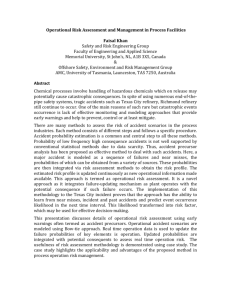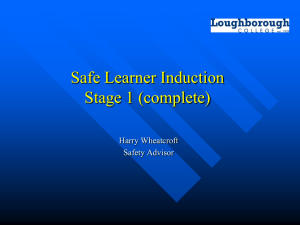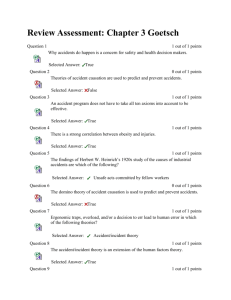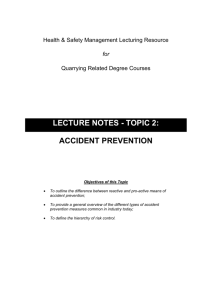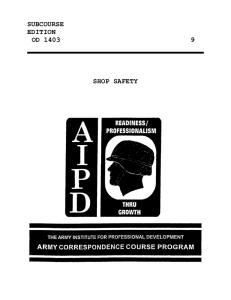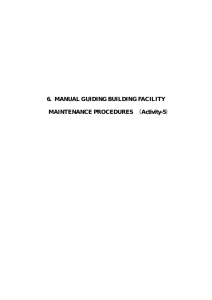Tilti Systems AG
advertisement
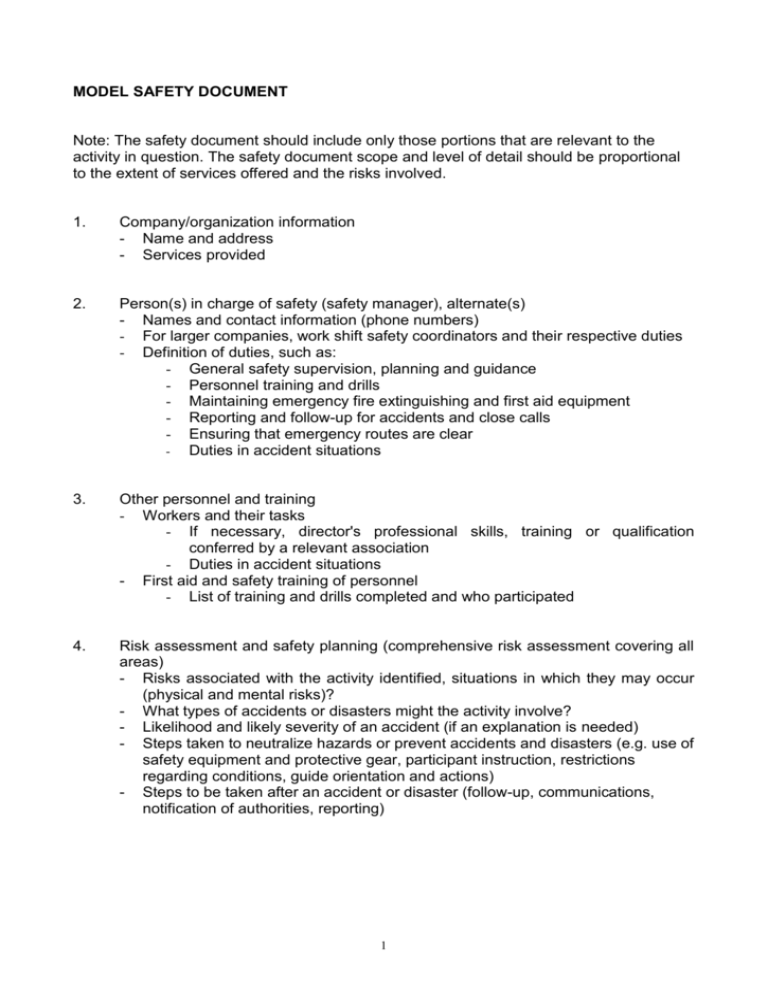
MODEL SAFETY DOCUMENT Note: The safety document should include only those portions that are relevant to the activity in question. The safety document scope and level of detail should be proportional to the extent of services offered and the risks involved. 1. Company/organization information - Name and address - Services provided 2. Person(s) in charge of safety (safety manager), alternate(s) - Names and contact information (phone numbers) - For larger companies, work shift safety coordinators and their respective duties - Definition of duties, such as: - General safety supervision, planning and guidance - Personnel training and drills - Maintaining emergency fire extinguishing and first aid equipment - Reporting and follow-up for accidents and close calls - Ensuring that emergency routes are clear - Duties in accident situations 3. Other personnel and training - Workers and their tasks - If necessary, director's professional skills, training or qualification conferred by a relevant association - Duties in accident situations - First aid and safety training of personnel - List of training and drills completed and who participated 4. Risk assessment and safety planning (comprehensive risk assessment covering all areas) - Risks associated with the activity identified, situations in which they may occur (physical and mental risks)? - What types of accidents or disasters might the activity involve? - Likelihood and likely severity of an accident (if an explanation is needed) - Steps taken to neutralize hazards or prevent accidents and disasters (e.g. use of safety equipment and protective gear, participant instruction, restrictions regarding conditions, guide orientation and actions) - Steps to be taken after an accident or disaster (follow-up, communications, notification of authorities, reporting) 1 5. Customers (participants) and customer groups - Maximum number of customers in different activities/locations at any one time, as determined by the activity organizer based on the risks involved with the service offered (often considerably lower than the maximum capacity of a facility as determined by authorities, for example) - Any requirements or limitations based on, for example, age, fitness, skills, other (e.g. prohibiting use of intoxicants) - Action required by changes in conditions (e.g. weather, lighting) - Participant equipment (type of clothing, footwear etc. required) 6. Instruction of participants - At what stage and how instruction is carried out (e.g. on the bus on the way to the activity site, at the activity site, video, demonstration, combination of different methods) - Explanation of risks involved in the activity - Rules of conduct, use of safety equipment and protective gear, emergency procedures - Special circumstances of instruction (such as darkness, cultural differences, language difficulties) 7. Buildings and structures (such as climbing walls, high and low obstacle courses, snow structures, accommodations) - List of buildings and structures - Map/plan of building and structure locations - Inspection and maintenance - Maintenance plan (inspection and maintenance times) - Maintenance log - Responsible person - Location of plans and strength calculations - Escape routes, shelters and arrangements for fire extinguishing and rescue tasks - Fire safety (list of fire control equipment such as fire alarms, extinguishers and fire blankets and their locations) - Fire inspections completed, chimney sweeping, portable extinguisher maintenance and inspection (recorded in maintenance log or similar) 8. Any animals to be used in the activities - Name and contact information of the person in charge - List of animals to be used for different activities - Instruction and supervision of customers - Restrictions and special care instructions for different animals used 2 9. Routes to be followed (especially for activities such as snowmobiling, dog sledding, white-water rafting, hiking, bicycling or canoeing) - Routes, perhaps indicated on attached maps - Rescue/pickup points known to rescue services - Identification of points along route posing special risks (such as roads, railroad tracks and areas of water to be crossed) and procedures to ensure safety. Optional alternative routes, if any 10. Safety equipment and protective gear - Name and contact information of the person in charge - List of safety equipment and protective gear and storage location - Inspection and maintenance - Maintenance plan (what is inspected and maintained and when) - Maintenance log (as part of daily record, for example) - Climbing and descending equipment usage log (separate from daily record) 11. Other equipment and tools (e.g. sports equipment, machines and devices) - Name and contact information of the person in charge - List of equipment and tools, storage location, and time of acquisition - Inspection and maintenance - Maintenance plan (inspection and maintenance times) - Maintenance log 12. Instructions for accidents and emergency situations - Instructions and means to summon help, back-up plan (taking into account any gaps in cell phone network coverage) - Leadership responsibility and delegation of tasks - Order of steps taken, administering first aid - List of first aid and rescue equipment and their locations - Evacuation plan - Search plan/instructions in case of customer going missing - Also, for safaris or similar activities, instructions in case of the guide becoming incapacitated or separated from the group 13. Fire management instructions - Fire management indoors - Heating-related hazards - Hazards related to candles and other means of lighting - Handling of oil or liquefied gas devices - Actions to take if a fire starts - Actions to take if odour of gas is detected - Procedures in case of carbon monoxide poisoning - Fire management outdoors - Hazards and restrictions related to lighting fires outdoors (e.g. during forest fire warnings), customer supervision 3 - Hazards associated with different types of cooking devices (e.g. stoves using alcohol, petrol or gas as fuel) - Precautions related to heated tent accommodations, such as appointing a "fire tender" and having water on hand for extinguishing - Actions to take if a fire starts 14. Accident recording and investigating the cause of an accident - Accidents, even small ones, and close calls of a serious nature - Regular utilization of the accident records: how frequently done and who is the person in charge - Description of arrangements for accident recording and investigation - Completion of incident report form - Submission of form to the person in charge - Accident analysis (e.g. what factors led to the occurrence of the accident?) - Considering procedures for the prevention of similar incidents in the future, and appointing a responsible person and drawing up a schedule for implementation of the procedures - Communication about the incident (person in charge and manner of communication) - Notification of the incident (municipal product safety surveillance authorities, occupational safety and health authorities, police, insurance company) 15. As needed, separate safety plans or instructions regarding individual activities and/or sites 16. Updating the safety document - Name of the responsible person - How often updated and when - Record of updates and short descriptions of updates made 4

